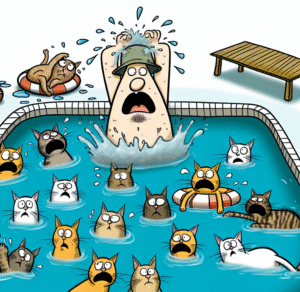- Weight loss isn’t just about counting calories and hitting the gym; it’s an intricate dance of biology, psychology, and perseverance.
- A calorie deficit isn’t a one-size-fits-all solution; looking at your metabolism, muscle mass, and even your sleep pattern is key.
- Frustration is normal, but waiting for results can sometimes be more about patience than perfection.
Ah, the age-old quest for weight loss! Take a seat and pour yourself a refreshing glass of kale juice (or a nice cup of coffee, because let’s be real, we’re in this together). A lot of you reading this have probably joined the community of gym-goers, smoothie drinkers, and calorie counters at some point. And like one of you recently said, you might feel like you’re stuck on a treadmill going nowhere. Confusing, right? Like that time you tried to understand the plot of Inception. So, what gives? Let’s unravel this mystery together.
The Basics: What Really Happens in Your Body?
The first thing we need to understand is that our bodies are intricate machines, not simply calculators where you add exercise and subtract calories. When you’re trying to lose weight, several biological factors come into play, such as:
Basal Metabolic Rate (BMR): This is the number of calories your body needs at rest to maintain basic bodily functions. Think of it like the power-up mode for our body.
Total Daily Energy Expenditure (TDEE): This is your BMR plus the calories you burn through daily activities and exercise. Your TDEE tells you how many calories you should consume to maintain your current weight.
Caloric Deficit: You need to consume fewer calories than your TDEE to lose weight. But don’t confuse this with extreme dieting. Drastic reductions can slow your metabolism.
Here’s a nifty comparison between BMR and TDEE:
| Metric | Example | Description |
|---|---|---|
| BMR | 1,500 calories/day | Calories burned at rest (sleeping, breathing) |
| TDEE | 2,000 calories/day | Total calories burned in a day (including exercise and daily activities) |
You can calculate your BMR using various online calculators or even better, rely on smart devices that have integrated this feature. After that, use your activity level to get to your TDEE. Easy peasy, right?
Understanding Weight Loss: The Numbers Game
Now, let’s talk numbers without putting you to sleep. A safe caloric deficit usually hovers around 500-1000 calories below your TDEE to allow for weight loss of about 1-2 pounds per week. But here’s the kicker: weight loss isn’t linear. Some weeks you might drop 2 pounds while others leave you scratching your head after losing only half a pound.
Here’s a little breakdown of expected weight loss:
| Week | Expected Weight Loss | Potential Reality |
|---|---|---|
| 1 | 1-2 pounds | 1 pound |
| 2 | 1-2 pounds | 0.5 pounds |
| 3 | 1-2 pounds | 2 pounds |
| 4 | 1-2 pounds | Stagnation |
Doesn’t it just make you want to throw your scale out the window? But, hold that thought!
Not All Calories Are Created Equal
Are you hitting your calorie deficit but still feeling like it’s a workout just to get out of bed? Not all calories are created equal, folks! 1200 calories of gummy bears isn’t the same as 1200 calories of chicken, broccoli, and quinoa, right? Here are a few key pointers:
Macronutrients Matter: Your body reacts differently to carbohydrates, proteins, and fats. Proteins help build muscle and can keep you full longer, while carbs provide that sweet energy kick (not just in the form of cake).
Micronutrients: Vitamins and minerals play their part too! You can’t just starve yourself and expect to lose weight healthily. Nutrient-deficient diets might cause fatigue, irritability, and even hair loss. No one wants that hangry version of you to come out on the first day of the 5th week!
Caloric Density vs. Nutrient Density
| Food Type | Calories (per 100g) | Nutritional Value |
|---|---|---|
| Avocado | 160 | Healthy fats, fiber |
| Almonds | 576 | Protein, healthy fats |
| Broccoli | 34 | Fiber, vitamins, phytonutrients |
| Candy Bar | 450 | Minimal nutrients |
As you can see from this table, a candy bar may fit your caloric target but is about as useful for weight loss as a chocolate teapot!
What About Exercise?
Exercise is important, but it’s just one component of the weight loss equation. You mention hitting the gym consistently, which is excellent! But let’s break down its role in this journey:
Building Muscle: Lifting weights or doing resistance training will help you build muscle mass. More muscle means a higher BMR, which translates to more calories burned even when you’re binge-watching that new series.
High-Intensity Interval Training (HIIT): If you’re short on time, HIIT can be your best friend. Short bursts of intense exercise can torch calories and improve endurance.
Cardio: Steady-state cardio (think jogging) helps, but make sure not to overdo it to avoid burnout or plateaus.
So, folks, mix it up! Attack that treadmill with a combination of workouts. Most importantly, listen to your body—Netflix marathons are cool, but they shouldn’t come at the expense of your workouts.
The Psychology of Weight Loss
Let’s turn down the heat for a second and consider the mental aspects. Weight loss isn’t just physical; there’s a significant psychological component. It’s like the proverbial iceberg of weight loss—the real struggles often lie beneath the surface. Here are some thoughts:
Expectations: You might be expecting rapid results, but the truth is that patience is a critical factor. Maybe it’s not you; it’s the body adjusting to a new routine.
Emotional Eating: Ever raided the fridge after a tough day? Yeah, we’ve all been there. Becoming aware of the triggers leading to emotional eating can be transformative.
Mindset Matters: Building a positive relationship with food can flip the script. Instead of a "diet," think of it as a lifestyle change. Does a kale-and-quinoa salad sound more appetizing than "salad"? Just a thought!
The Advantages & Disadvantages of Current Practices
Advantages
- Awareness: Calculating calories pushes you to make more conscious dietary choices.
- Structure: A defined plan keeps you on track and can provide motivation.
- Support Communities: From online forums to local support groups, you’re not alone in your struggle.
Disadvantages
- Obsessive Behavior: Tracking can sometimes lead to an unhealthy obsession with food and exercise, making it feel like a chore.
- Nutritional Deficiency: Ignoring micronutrients can lead to fatigue or health issues.
- Burnout: Extreme dieting or over-exercising can lead to long-term setbacks.
The Future of Weight Loss: What’s Next?
Imagine a world where fitness is not just a workout but a full-blown experience fueled by technology. Think about how personalized fitness apps can analyze your data, dietary preferences, and even your mood to tailor weight loss programs just for you. One can dream, right?
Wearable Tech: Smart watches that track everything from heart rate to sleep patterns will give you an all-round spectrum of your health.
Diet Customization via AI: With advancements in artificial intelligence, we might soon have AI dietitians that create meal plans based on genetic profiles.
Virtual Reality Workouts: Getting your exercise fix without leaving your living room? Sign me up! Imagine being on a beach in Hawaii while you’re sweating it out on the treadmill!
Ethical Considerations
As we embrace these advances, we must carry a healthy dose of caution. Who sets the standards for ideal body types? What happens when technology invades personal health choices? The conversation surrounding body image, ethics, and the impact of social media needs addressing.
Body Positivity: Always remember that health is not just about weight. Mental wellness is just as important as physical fitness.
Accessibility: Tech-driven solutions need to be accessible to all. Gym equipment and health apps shouldn’t be luxuries; they should be a standard.
Conclusion: The Long Game
So, what’s the takeaway? There isn’t a single button you can press to start losing weight. It’s not about perfection or restrictive diets—it’s about embracing the journey, patching together the pieces of a complex puzzle, and being kind to yourself when the scale doesn’t budge like you want it to.
Finding what works for you personally is the name of the game. Whether it’s striking a balance with your diet, exploring new types of exercise, or even getting headspace to untangle stress, every small step counts.
So, keep going, and remember: your journey is uniquely yours!
Keywords: weight loss, caloric deficit, metabolism, exercise, nutrition, mental health, macronutrients, healthy lifestyle, technology, mindfulness.





